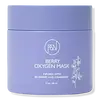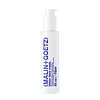What's inside
What's inside
 Key Ingredients
Key Ingredients

 Benefits
Benefits

 Concerns
Concerns

 Ingredients Side-by-side
Ingredients Side-by-side

Water
Skin ConditioningKaolin
AbrasiveAloe Barbadensis Leaf Juice
Skin ConditioningGlycerin
HumectantSodium Stearate
CleansingCetyl Alcohol
EmollientSqualane
EmollientLactic Acid
BufferingIsopropyl Palmitate
EmollientGlyceryl Stearate
EmollientPhenoxyethanol
PreservativeVaccinium Macrocarpon Fruit Powder
AntioxidantParfum
MaskingStearyl Alcohol
EmollientCetearyl Alcohol
EmollientCocos Nucifera Oil
MaskingHibiscus Sabdariffa Flower Powder
AbrasiveGlycolic Acid
BufferingXanthan Gum
EmulsifyingSodium Hydroxide
BufferingCetearyl Glucoside
EmulsifyingEthylhexylglycerin
Skin ConditioningTocopheryl Acetate
AntioxidantTetrasodium Glutamate Diacetate
Sodium Benzoate
MaskingPotassium Sorbate
PreservativeCamellia Sinensis Leaf Extract
AntimicrobialUbiquinone
AntioxidantSclerotium Gum
Emulsion StabilisingSaccharum Officinarum Extract
MoisturisingPyrus Malus Fruit Extract
Skin ConditioningPhytic Acid
Lysolecithin
EmulsifyingLonicera Caprifolium Flower Extract
PerfumingLecithin
EmollientDipeptide Diaminobutyroyl Benzylamide Diacetate
Skin ConditioningCymbopogon Schoenanthus Oil
MaskingCitrus Medica Limonum Peel Extract
EmollientCitrus Aurantium Dulcis Peel Extract
Emulsion StabilisingAscorbic Acid
AntioxidantPullulan
Butylene Glycol
HumectantAcetyl Hexapeptide-8
HumectantVitis Vinifera Seed Oil
EmollientSimmondsia Chinensis Seed Oil
EmollientRosa Canina Seed Oil
EmollientCalophyllum Inophyllum Seed Oil
AntimicrobialPrunus Armeniaca Kernel Oil
MaskingSodium Ascorbyl Phosphate
AntioxidantVaccinium Angustifolium Fruit Extract
Skin ProtectingVinca Minor Extract
Skin ConditioningMahonia Aquifolium Root Extract
AstringentGlycyrrhiza Glabra Root Extract
BleachingCassia Angustifolia Seed Polysaccharide
Skin ConditioningHydroxyethylcellulose
Emulsion StabilisingWater, Kaolin, Aloe Barbadensis Leaf Juice, Glycerin, Sodium Stearate, Cetyl Alcohol, Squalane, Lactic Acid, Isopropyl Palmitate, Glyceryl Stearate, Phenoxyethanol, Vaccinium Macrocarpon Fruit Powder, Parfum, Stearyl Alcohol, Cetearyl Alcohol, Cocos Nucifera Oil, Hibiscus Sabdariffa Flower Powder, Glycolic Acid, Xanthan Gum, Sodium Hydroxide, Cetearyl Glucoside, Ethylhexylglycerin, Tocopheryl Acetate, Tetrasodium Glutamate Diacetate, Sodium Benzoate, Potassium Sorbate, Camellia Sinensis Leaf Extract, Ubiquinone, Sclerotium Gum, Saccharum Officinarum Extract, Pyrus Malus Fruit Extract, Phytic Acid, Lysolecithin, Lonicera Caprifolium Flower Extract, Lecithin, Dipeptide Diaminobutyroyl Benzylamide Diacetate, Cymbopogon Schoenanthus Oil, Citrus Medica Limonum Peel Extract, Citrus Aurantium Dulcis Peel Extract, Ascorbic Acid, Pullulan, Butylene Glycol, Acetyl Hexapeptide-8, Vitis Vinifera Seed Oil, Simmondsia Chinensis Seed Oil, Rosa Canina Seed Oil, Calophyllum Inophyllum Seed Oil, Prunus Armeniaca Kernel Oil, Sodium Ascorbyl Phosphate, Vaccinium Angustifolium Fruit Extract, Vinca Minor Extract, Mahonia Aquifolium Root Extract, Glycyrrhiza Glabra Root Extract, Cassia Angustifolia Seed Polysaccharide, Hydroxyethylcellulose
Water
Skin ConditioningCocamidopropyl Betaine
CleansingGlycerin
HumectantMethyl Perfluoroisobutyl Ether
SolventMethyl Perfluorobutyl Ether
SolventStearic Acid
CleansingGlycine Soja Oil
EmollientCarrageenan
Palmitic Acid
EmollientCetyl Alcohol
EmollientSodium PCA
HumectantPanthenol
Skin ConditioningSodium Coco-Sulfate
CleansingButylene Glycol
HumectantSqualane
EmollientDimethicone
EmollientCocamidopropyl Hydroxysultaine
CleansingCoco-Glucoside
CleansingCamellia Sinensis Leaf Extract
AntimicrobialCaprylyl Glycol
Emollient1,2-Hexanediol
Skin ConditioningPolyhydroxystearic Acid
EmulsifyingSodium Hydroxide
BufferingAllantoin
Skin ConditioningLecithin
EmollientIsononyl Isononanoate
EmollientEthylhexyl Isononanoate
EmollientHydrolyzed Soy Protein
HumectantXanthan Gum
EmulsifyingSodium Cocamidopropyl Pg-Dimonium Chloride Phosphate
CleansingTocopheryl Acetate
AntioxidantPrunus Amygdalus Dulcis Oil
Skin ConditioningPEG-90m
Emulsion StabilisingArginine
MaskingPerfluorohexane
SolventPotassium Hydroxide
BufferingO-Cymen-5-Ol
AntimicrobialAloe Barbadensis Leaf Juice
Skin ConditioningBenzaldehyde
MaskingTetrahexyldecyl Ascorbate
AntioxidantTropolone
Skin ConditioningTocopherol
AntioxidantWater, Cocamidopropyl Betaine, Glycerin, Methyl Perfluoroisobutyl Ether, Methyl Perfluorobutyl Ether, Stearic Acid, Glycine Soja Oil, Carrageenan, Palmitic Acid, Cetyl Alcohol, Sodium PCA, Panthenol, Sodium Coco-Sulfate, Butylene Glycol, Squalane, Dimethicone, Cocamidopropyl Hydroxysultaine, Coco-Glucoside, Camellia Sinensis Leaf Extract, Caprylyl Glycol, 1,2-Hexanediol, Polyhydroxystearic Acid, Sodium Hydroxide, Allantoin, Lecithin, Isononyl Isononanoate, Ethylhexyl Isononanoate, Hydrolyzed Soy Protein, Xanthan Gum, Sodium Cocamidopropyl Pg-Dimonium Chloride Phosphate, Tocopheryl Acetate, Prunus Amygdalus Dulcis Oil, PEG-90m, Arginine, Perfluorohexane, Potassium Hydroxide, O-Cymen-5-Ol, Aloe Barbadensis Leaf Juice, Benzaldehyde, Tetrahexyldecyl Ascorbate, Tropolone, Tocopherol
Ingredients Explained
These ingredients are found in both products.
Ingredients higher up in an ingredient list are typically present in a larger amount.
Aloe Barbadensis Leaf Juice comes from leaves of the aloe plant. Aloe Barbadensis Leaf Juice is best known for helping to soothe sunburns. It is also anti-inflammatory, moisturizing, antiseptic, and can help heal wounds.
Aloe is packed with good stuff including Vitamins A, C, and E. These vitamins are antioxidants, which help fight free-radicals and the damage they may cause. Free-radicals are molecules that may damage your skin cells, such as pollution.
Aloe Barbadensis Leaf Juice also contains sugars. These sugars come in the form of monosaccharides and polysaccharides, folic acid, and choline. These sugars are able to help bind moisture to skin.
It also contains minerals such as calcium, 12 anthraquinones, fatty acids, amino acids, and Vitamin B12.
Learn more about Aloe Barbadensis Leaf JuiceButylene Glycol (or BG) is used within cosmetic products for a few different reasons:
Overall, Butylene Glycol is a safe and well-rounded ingredient that works well with other ingredients.
Though this ingredient works well with most skin types, some people with sensitive skin may experience a reaction such as allergic rashes, closed comedones, or itchiness.
Learn more about Butylene GlycolCamellia Sinensis Leaf Extract is derived from the leaves of the tea plant. Black tea, green tea, and oolong tea are all harvested from this plant.
This ingredient has many skin benefits:
This ingredient contains polyphenols, a strong antioxidant. Antioxidants help fight off molecules that damage skin cells.
On top of that, the antioxidants in green tea neutralize free-radicals from the sun. This gives the skin some extra UV protection, but should not replace sunscreen.
Many components of tea have anti-inflammatory properties.
Polyphenols and L-theanine help soothe the skin and reduce irritation. The caffeine in Camellia Sinensis Leaf Extract helps calm inflamed blood vessels.
Other compounds found in tea include: Vitamin Bs, linoleic acid, magnesium, calcium, iron, and zinc.
Research has shown both drinking Camellia Sinensis Leaf Tea and applying it to the skin can help boost skin elasticity and hydration. Studies also show using tea extract may reduce sebum, or oil, production.
Learn more about Camellia Sinensis Leaf ExtractCetyl Alcohol is a fatty alcohol. Fatty Alcohols are most often used as an emollient or to thicken a product.
Its main roles are:
Though it has "alcohol" in the name, it is not related to denatured alcohol or ethyl alcohol.
The FDA allows products labeled "alcohol-free" to have fatty alcohols.
Learn more about Cetyl AlcoholGlycerin is already naturally found in your skin. It helps moisturize and protect your skin.
A study from 2016 found glycerin to be more effective as a humectant than AHAs and hyaluronic acid.
As a humectant, it helps the skin stay hydrated by pulling moisture to your skin. The low molecular weight of glycerin allows it to pull moisture into the deeper layers of your skin.
Hydrated skin improves your skin barrier; Your skin barrier helps protect against irritants and bacteria.
Glycerin has also been found to have antimicrobial and antiviral properties. Due to these properties, glycerin is often used in wound and burn treatments.
In cosmetics, glycerin is usually derived from plants such as soybean or palm. However, it can also be sourced from animals, such as tallow or animal fat.
This ingredient is organic, colorless, odorless, and non-toxic.
Glycerin is the name for this ingredient in American English. British English uses Glycerol/Glycerine.
Learn more about GlycerinLecithin is a term for a group of substances found in the cell membranes of plants, animals, and humans. They are made up of mixture of phospholipids.
This ingredient has emollient and emulsifying properties.
As an emollient, lecithen helps soften the skin and creates a barrier to keep moisture in.
As an emulsifier, it also helps prevent water and oil ingredients from separating. Lecithin can also help ingredients be better absorbed by the skin.
This is because the phospholipids in lecithin produce liposomes. Liposomes help other ingredients get through the skin barrier.
Depending on the source of this ingredient, lecithin may not be fungal acne safe. This is because some sources of lecithin come from soybean oil, which may feed the malassezia yeast that feeds fungal acne.
We recommend reaching out to the brand you are purchasing from to inquire about the source of their lecithin.
Some other names for this ingredient include soy lecithin and deoiled soy lecithin.
Learn more about LecithinSodium Hydroxide is also known as lye or caustic soda. It is used to adjust the pH of products; many ingredients require a specific pH to be effective.
In small amounts, sodium hydroxide is considered safe to use. However, large amounts may cause chemical burns due to its high alkaline.
Your skin has a natural pH and acid mantle. This acid mantle helps prevent harmful bacteria from breaking through. The acid mantle also helps keep your skin hydrated.
"Alkaline" refers to a high pH level. A low pH level would be considered acidic.
Learn more about Sodium HydroxideSqualane is an emollient that helps the skin hold onto moisture. It's an oily liquid that occurs naturally in certain types of fish and plant oils.
Because squalane boosts hydration in the skin, it also comes with plenty of benefits: it is an antioxidant and can help fight free radicals and skin damage. Squalane is also found to have a detoxifying effect when applied.
Squalane comes from squalene, which occurs naturally within the sebum of our skin. It is one of the oils our skin produces to keep itself hydrated. Squalane is the hydrogenated version of squalene and has a longer shelf life.
Research shows that squalane is non-irritating (even at 100% concentration).
In general, it's a fantastic ingredient. It does a great job at hydrating the skin, and it's suitable for those with sensitive skin.
The source of squalane may impact malassezia / fungal acne. This is because olive oil derived squalane can contain impurities such as fatty acids and plant waxes. Sugarcane derived squalane is recommended for anyone with malassezia concerns.
Is squalane vegan?
This depends on the source. Squalane can be derived from both plants and animals. Most squalane used in skincare comes from plants.
Please note: the source of squalane is only known if disclosed by the brand. We recommend reaching out to the brand if you have any questions about their squalane.
Read more about squalene with an "e".
Is squalane an oil?
Squalane is often called an oil, but it’s technically not; it’s a hydrocarbon, meaning it’s only made of carbon and hydrogen, unlike true oils which are triglycerides made of fatty acids and glycerol.
The term “oil-free” isn’t regulated, so companies can define it however they want. Some exclude all oils, while others just avoid mineral oil or comedogenic oils.
While some people avoid oils thinking they cause breakouts, the right kind of oil (or oil-like ingredient like squalane) can actually help balance and hydrate your skin. It’s worth testing out simple oils or squalane to see what works best for your skin.
Learn more about SqualaneTocopheryl Acetate is AKA Vitamin E. It is an antioxidant and protects your skin from free radicals. Free radicals damage the skin by breaking down collagen.
One study found using Tocopheryl Acetate with Vitamin C decreased the number of sunburned cells.
Tocopheryl Acetate is commonly found in both skincare and dietary supplements.
Learn more about Tocopheryl AcetateWater. It's the most common cosmetic ingredient of all. You'll usually see it at the top of ingredient lists, meaning that it makes up the largest part of the product.
So why is it so popular? Water most often acts as a solvent - this means that it helps dissolve other ingredients into the formulation.
You'll also recognize water as that liquid we all need to stay alive. If you see this, drink a glass of water. Stay hydrated!
Learn more about WaterXanthan gum is used as a stabilizer and thickener within cosmetic products. It helps give products a sticky, thick feeling - preventing them from being too runny.
On the technical side of things, xanthan gum is a polysaccharide - a combination consisting of multiple sugar molecules bonded together.
Xanthan gum is a pretty common and great ingredient. It is a natural, non-toxic, non-irritating ingredient that is also commonly used in food products.
Learn more about Xanthan Gum